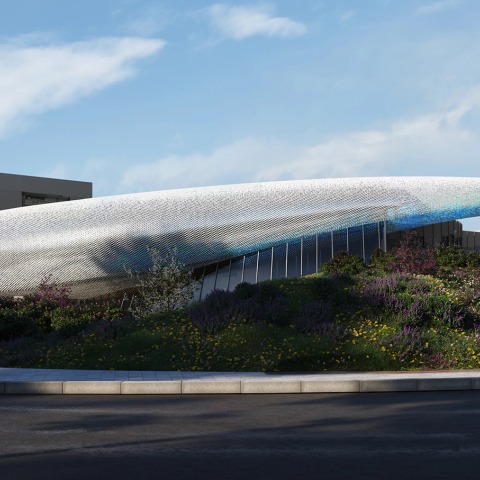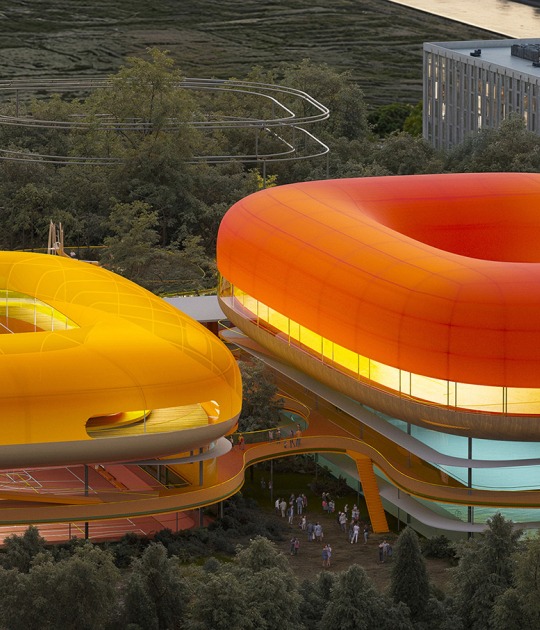Project description by Pich Architects
Climate Shelter: The fusion of art, nature and community forms the heart of the new urban landscape.
Pich Architects, recognized for the execution of architectural projects that tend to establish an enriching connection with nature and an appropriate use of natural resources, has been the studio selected to carry out the project from among the different proposals presented.
The architects Felipe Pich-Aguilera and Teresa Batlle, with their team and the collaboration of Arup Spain, will be the architects of this new structure in the heart of the urban landscape that, like a large drop of water, fertilizes the territory. The organic shape of the unique roof will not only be aesthetic, but will also act as a climatic shelter, since the building will be oriented along the entire path of the solar arc to form a cadence of sections that will allow the incidence of the sun to be modulated according to the seasons of the year. .
The project goes beyond the creation of new infrastructure: it is an active companion in the daily lives of citizens. Whether walking through the park, pedaling a bicycle or driving along the junction, the building will be designed to accompany the people who interact with it and to improve their quality of life. The mission is to merge architectural functionality with the projection of an environment in a way that both cultural development and community connection are nurtured.

Display. Málaga Caixa Forum by Pich Architects.
Innovation, spearhead of the new center
In environmental terms, CaixaForum Málaga will be a zero-balance building, given that it will produce all the energy it consumes. The center will have excellent performance, both in CO2 emissions and energy demand (thermal and lighting).
The project addresses climate change mitigation and adaptation through a bioclimatic approach. In this way, the garden's vegetation will adapt to the local climate, while the buildings will have roofs strategically designed to respond to climatic considerations. These covers include vegetal covers, photovoltaic panels and reflective ceramic pieces to prevent the accumulation of solar heat.
Regarding water saving and biodiversity, measures such as rainwater collection, gray water recirculation for internal use and the use of garden roofs to retain water will be implemented. Likewise, plant species with moderate water demand will be adopted, thus contributing to the creation of a diverse and stable natural ecosystem.
On the other hand, future European directives will be taken into account in the construction of the center. The meticulous selection and application of materials, which prioritizes those from local manufacturers and suppliers, and those with recycled content, reflects the project's commitment to environmental responsibility and, in turn, support for the local economy.

Display. Málaga Caixa Forum by Pich Architects.
Mediterranean inspiration
Innovation is another of the main vectors of the architecture of this project: its large roof in the shape of a drop of water is once again the protagonist. Its envelope is made up of a natural material such as ceramic and allows air to flow through it to provide thermodynamic comfort. It will integrate LED lighting that allows not only low-consumption night lighting of the building, but also the possibility of informing the public about CaixaForum news and drawing the attention of people passing through its surroundings. Its design will allow the representation of motion graphics and high definition video content.
The team of architects has taken into account the Mediterranean component of ceramics. For the conception of the pieces of the cover, which will be shaped like scales with shades of colors between blue and green on a white background, it has been inspired by the rich chromaticism of Joaquín Sorolla, one of the painters who best reflected light. Mediterranean and a lover of the city of Malaga.

Display. Málaga Caixa Forum by Pich Architects.
Three decades of cultural commitment in Malaga
In the cultural field, the "la Caixa" Foundation has been present in Malaga for three decades, since it began its programming in 1993 with the Science Tent. Over the years it has organized more than 50 traveling projects in the city, among which those dedicated to Sebastião Salgado or Leonardo da Vinci stand out, exhibitions such as Tierra de Sueños, by Cristina García Rodero, or De Polo a Polo, with National Geographic, and the immersive musical experience Symphony, directed by Gustavo Dudamel.
This cultural dedication is complemented by the constant work in Malaga of the “la Caixa” Foundation in social, scientific and educational areas. The entity carries out various programs in the city, including initiatives against child poverty, the promotion of employment for people in vulnerable situations, the promotion of active and healthy aging or care for people with advanced illnesses.






































